Consulting Editor Ramesh Kumar, back from a grueling 35-day road trip covering over 3,000 km in the north-eastern states of Assam and Arunachal Pradesh, shares his observations
Omnipresent, Omniscient!
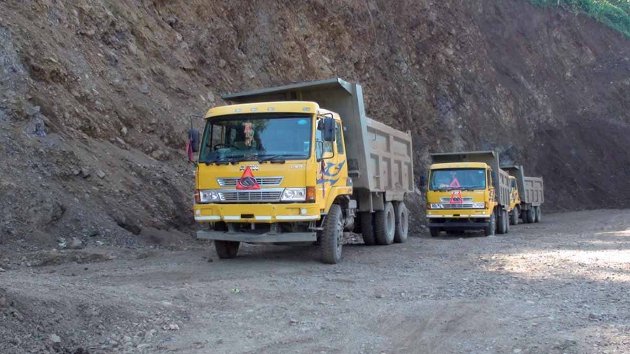
As I sped across the National Highway 229 – also known as Trans Arunachal Highway (TAH) – I could not help noticing the omnipresence of AMW all along the route. Several hundred metres above the Mighty Siang (that is how Arunachalis call the Mighty Brahmaputra, the perennial river), this prestigious Prime Minister’s gift to the largest northeastern state, AMWs dot every single kilometer where blasted mountains and highway construction is in full swing.
I remember spotting the red-colored AMW in November 2010 only in Gujarat and calling up Bhavna Singh at the company’s BandraKurla Complex and asking her, “Why is it not seen outside Gujarat?”. Wait and see, she told me then. A few months later, I spotted a few in Udupi, Karnataka and SMS-ed her. Honestly, I never anticipated that this Bhuj-based HCV manufacturer would make such an impact particularly in the construction & mining industry. Yes, they have done it. On my way to Ziro, Arunachal Pradesh in November I halted on the roadside noticing another AMW and two men busy replacing a punctured tyre. How does he find this vehicle? I asked him. “Aapkudh drive karkidekh lo,” said the sprightly youngster from West Bengal. I didn’t. No need to. Its omnipresence is a tell-tale response to its popularity among construction and mining contractors. Well done, AMW!
Yellow, yellow!
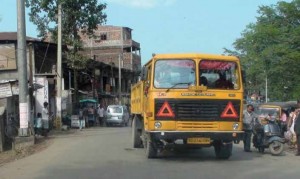 Hang on. It does not mean, other HCV giants are vamoosed. No. Not at all. On my way to Stilwell Road … Wait …. Wait… Do you know the historical importance of Stilwell Road? No? Relax. Let me explain. At the height of World War II, the Allied Forces built a 1,736 km road linking India (Assam) with China (Kunming) via Myanmar (then known as Burma) in a record time of less than 30 months to move troops to fight the Japanese. Okay. Now back to the point I wanted to make. Ashok Leyland trucks too are highly visible. Many of them sport a bright yellow.
Hang on. It does not mean, other HCV giants are vamoosed. No. Not at all. On my way to Stilwell Road … Wait …. Wait… Do you know the historical importance of Stilwell Road? No? Relax. Let me explain. At the height of World War II, the Allied Forces built a 1,736 km road linking India (Assam) with China (Kunming) via Myanmar (then known as Burma) in a record time of less than 30 months to move troops to fight the Japanese. Okay. Now back to the point I wanted to make. Ashok Leyland trucks too are highly visible. Many of them sport a bright yellow.
Don’t know why? As I trawl towards Stilwell Road, I bump into an AL truck, near Margharita railway crossing (a locality named to honour the Italian troops that fought valiantly in World War II), in Assam. By the way, Ashok Leyland and Tata continue to be the favourite vehicle of Border Road Organisation(BRO) that was set up post India-China war of 1962 to take care of building roads and highways on border areas. They are not yellow-painted, but dark blue.
Construction boom
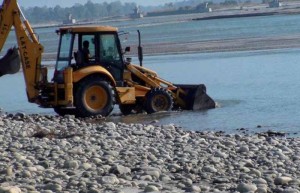 Life in northeast is tough. Remember you have to deal with the mighty Brahmaputra or mighty Siang. Yes, they are the one and same river. They change their course when in spate. Bridges vanish putting people to hardship and untold miseries. On the one hand, the state of Arunachal Pradesh has no infrastructure to boast of.
Life in northeast is tough. Remember you have to deal with the mighty Brahmaputra or mighty Siang. Yes, they are the one and same river. They change their course when in spate. Bridges vanish putting people to hardship and untold miseries. On the one hand, the state of Arunachal Pradesh has no infrastructure to boast of.
Add the fury of river that rocks whatever little transportation facilities in the form of barges that ferry people and smaller vehicles across the river. Thankfully, the rulers don’t give up so easily. Huge dollops of money ploughed into creating pathways. When companies boast of ‘Builders of Nation’, you realize the real import of that slogan when you visit such crisis-hit northeast parts.
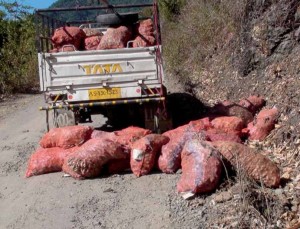 Boulders that came tumbling down the river from higher mountains are scooped by might L&T-Case cranes from riverbeds and dumped into the several feet deep rivers to create pathways across rivers and make motoring possible in the shortest possible time.
Boulders that came tumbling down the river from higher mountains are scooped by might L&T-Case cranes from riverbeds and dumped into the several feet deep rivers to create pathways across rivers and make motoring possible in the shortest possible time.
Even before the sun could peep from behind the Himalayas near Tezu, Arunachal Pradesh, heavy equipment and crane charioteers have geared up to contribute their might. Criticism is easy, but construction is tough.
Builder first, then grower!
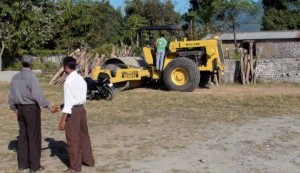 Construction is a cottage industry in Arunachal Pradesh definitely. Even a rich orange orchard (bagan) owner will not hide the fact that he is a ‘civil contractor’. Either he is busy building a culvert or laying a small stretch of road in this state. What about his fruiting business? He will tell you that the gestation period of orange is six to seven years. So also pine apple.
Construction is a cottage industry in Arunachal Pradesh definitely. Even a rich orange orchard (bagan) owner will not hide the fact that he is a ‘civil contractor’. Either he is busy building a culvert or laying a small stretch of road in this state. What about his fruiting business? He will tell you that the gestation period of orange is six to seven years. So also pine apple.
What about maintenance? “What maintenance? Our agro-climatic condition is so good, nothing is required,” he would respond. Naturally, given the long gestation period, he is busy doing some ‘constructive’ work to keep his body and soul together till fruiting happens! Honestly, I have seen more construction machineries and equipments almost everywhere!
Trustworthy Tatas
If roads don’t exist, it does not mean people don’t eat or don’t move. Tata Mobiles are the favorite mode of transport. An apple orchard owner tells he buys several Tata Mobile loads of cow dung from a nearby village or army camp to meet his ‘organic’ needs. No fertilizer, but compost made of cowdung and agri-waste. Well, the point to note is ‘Tata Mobile’ is the measurement for his cowdung requirement. Since trucks or lorries are tough to ply on Arunachal roads, these mini Tata goods carriers are most sought after. Oranges, kiwis, pineapple, tomato etc. are carted to nearby cities to be reloaded onto six-wheel trucks for far off Tinsukia, Dibrugarh, Tezpur and Guwahati.
A broken down Tata Mobile with fresh ginger was awaiting a replacement tyre or vehicle on the road to Roing. “Don’t worry. Nobody will steal it. The only worry is pigs,” tells a farmer of the nearby field. It is a small world and everyone knows everyone else. Theft is rare. By the way, I have hardly seen a policeman over three weeks of my stay in Arunachal. Crime free state? Maybe.
Andhra Eggs for Assam
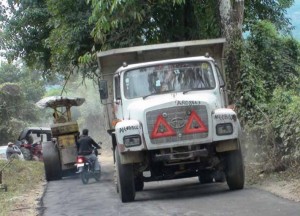 I lost count of trucks laden with eggs from Vijayawada reaching Assam and Arunachal Pradesh. “Andhra fish for Bengalis but Andhra eggs for us,” tells an Assamese friend in Tinsukia. Near the old railway station, egg carrying trucks block most of the road.
I lost count of trucks laden with eggs from Vijayawada reaching Assam and Arunachal Pradesh. “Andhra fish for Bengalis but Andhra eggs for us,” tells an Assamese friend in Tinsukia. Near the old railway station, egg carrying trucks block most of the road.
Out of curiosity, I ask the unloading group: “What’s the percentage of broken eggs due to bad road conditions?” Who cares, pat comes the reply. Two days later I run into a shop keeper in Ledo, the last railway station on the Indo-Myanmar border and repeat the same question. “They are well protected. I have not come across more than one or two eggs out of each carton showing signs of wear and tear,” he tells me. Sturdy Andhra eggs, huh!
Number mystery
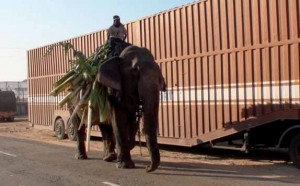 Look at the above Tata truck. Seen? Check out again. Now answer this question: how many times the truck registration number is written on the bonnet? No? Don’t look at it again. Just guess. One?Two?Three? …. Yes, three times the registration number ‘AR 08663’ is written.
Look at the above Tata truck. Seen? Check out again. Now answer this question: how many times the truck registration number is written on the bonnet? No? Don’t look at it again. Just guess. One?Two?Three? …. Yes, three times the registration number ‘AR 08663’ is written.
What’s so special, you ask. By and large, most vehicles don’t sport any number plate in Arunachal Pradesh: be it truck, passenger car. “Where is the need if you don’t move into Assam?” asks a friend whose trucks also never sported numberplates for years.
Those who have to travel from one district to another even within Arunachal, must have number plates. Why? Because you simply cannot move from one district to another within Arunachal directly.
You have no option but to exit Arunachal, enter Assam, travel some distance and then re-enter Arunachal. If you don’t have a numberplate, Assam police will catch and penalize you. Now the numberplate mystery solved? What kind of regulatory system does Arunachal have, I wonder.
Dig, Dig…
When road and highway construction is in full swing, CAT and Doosan cannot be far away.
Right of way to pachyderms
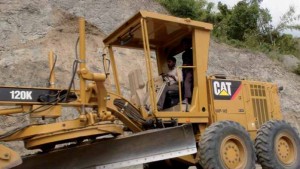 Remember to give way for elephants on National Highway 37. As you approach the Kaziranga National Park on the Assam-Tinsukia road, mahout-riding elephants will be a common sight. Better move to left and permit the gigantic vegetarian animal to proceed further.
Remember to give way for elephants on National Highway 37. As you approach the Kaziranga National Park on the Assam-Tinsukia road, mahout-riding elephants will be a common sight. Better move to left and permit the gigantic vegetarian animal to proceed further.
Wait for a while and then overtake. What if the mahout feels that you were ‘terrified’ of his ‘ghoda’? Don’t make the mistake of thinking that these pachyderms are tamed. Not at all. They are still ‘wild’, the mahouts will tell you with authority. Why take risk?